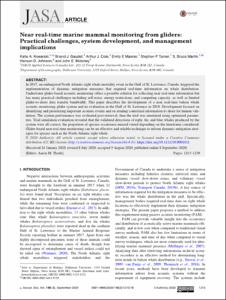| dc.contributor.author | Kowarski, Katie A. | |
| dc.contributor.author | Gaudet, Briand J. | |
| dc.contributor.author | Cole, Arthur J. | |
| dc.contributor.author | Maxner, Emily E. | |
| dc.contributor.author | Turner, Stephen P. | |
| dc.contributor.author | Martin, S. Bruce | |
| dc.contributor.author | Johnson, Hansen D. | |
| dc.contributor.author | Moloney, John E. | |
| dc.coverage.spatial | North Atlantic Ocean | en_US |
| dc.coverage.spatial | North Pacific Ocean | en_US |
| dc.date.accessioned | 2021-11-19T18:05:34Z | |
| dc.date.available | 2021-11-19T18:05:34Z | |
| dc.date.issued | 2020 | |
| dc.identifier.citation | Kowarski, Katie A., et al (2020) Near real-time marine mammal monitoring from gliders: practical challenges, system development, and management implications. Journal of the Acoustical Society of America, 148, pp.1215-1230. DOI: https://doi.org/10.1121/10.0001811 | en_US |
| dc.identifier.uri | https://repository.oceanbestpractices.org/handle/11329/1789 | |
| dc.description.abstract | In 2017, an endangered North Atlantic right whale mortality event in the Gulf of St. Lawrence, Canada, triggered the
implementation of dynamic mitigation measures that required real-time information on whale distribution.
Underwater glider-based acoustic monitoring offers a possible solution for collecting near real-time information but
has many practical challenges including self-noise, energy restrictions, and computing capacity, as well as limited
glider-to-shore data transfer bandwidth. This paper describes the development of a near real-time baleen whale
acoustic monitoring glider system and its evaluation in the Gulf of St. Lawrence in 2018. Development focused on
identifying and prioritizing important acoustic events and on sending contextual information to shore for human validation. The system performance was evaluated post-retrieval, then the trial was simulated using optimized parameters. Trial simulation evaluation revealed that the validated detections of right, fin, and blue whales produced by the
system were all correct; the proportion of species occurrence missed varied depending on the timeframe considered.
Glider-based near real-time monitoring can be an effective and reliable technique to inform dynamic mitigation strategies for species such as the North Atlantic right whale. | en_US |
| dc.language.iso | en | en_US |
| dc.rights | Attribution 4.0 International | * |
| dc.rights.uri | http://creativecommons.org/licenses/by/4.0/ | * |
| dc.subject.other | BioICE | |
| dc.subject.other | IOOS Marine Life | |
| dc.title | Near real-time marine mammal monitoring from gliders: Practical challenges, system development, and management implications. | en_US |
| dc.type | Journal Contribution | en_US |
| dc.description.refereed | Refereed | en_US |
| dc.format.pagerange | pp.1215 - 1230 | en_US |
| dc.identifier.doi | https://doi.org/10.1121/10.0001811 | |
| dc.subject.parameterDiscipline | Environment | en_US |
| dc.subject.instrumentType | Passive acoustic recording systems | en_US |
| dc.subject.dmProcesses | Data analysis | en_US |
| dc.subject.dmProcesses | Data aggregation | en_US |
| dc.subject.dmProcesses | Data acquisition | en_US |
| dc.subject.dmProcesses | Data exchange | en_US |
| dc.subject.dmProcesses | Data delivery | en_US |
| dc.bibliographicCitation.title | Journal of the Acoustical Society of America | en_US |
| dc.bibliographicCitation.volume | 148 | en_US |
| dc.description.sdg | 14.a | en_US |
| dc.description.eov | Marine turtles, birds, mammals abundance and distribution | en_US |
| dc.description.eov | Ocean sound | en_US |
| dc.description.adoption | International | en_US |
| dc.description.ebv | Species Populations | en_US |
| dc.description.ebv | Species Traits | en_US |
| dc.description.ebv | Community composition | en_US |
| dc.description.ebv | Ecosystem Structure | en_US |
| dc.description.ecv | Marine Habitats | en_US |
| dc.description.sensors | Passive Acoustic Recorders | en_US |
| obps.endorsementAuthorDeclared.recommendedPractice | used by multiple scientists and organizations | |
| obps.contact.contactname | Katie Kowarski | |
| obps.contact.contactemail | katie.kowarski@jasco.com | |
| obps.resourceurl.publisher | https://asa.scitation.org/doi/10.1121/10.0001811 | |
 Repository of community practices in Ocean Research, Applications and Data/Information Management
Repository of community practices in Ocean Research, Applications and Data/Information Management

